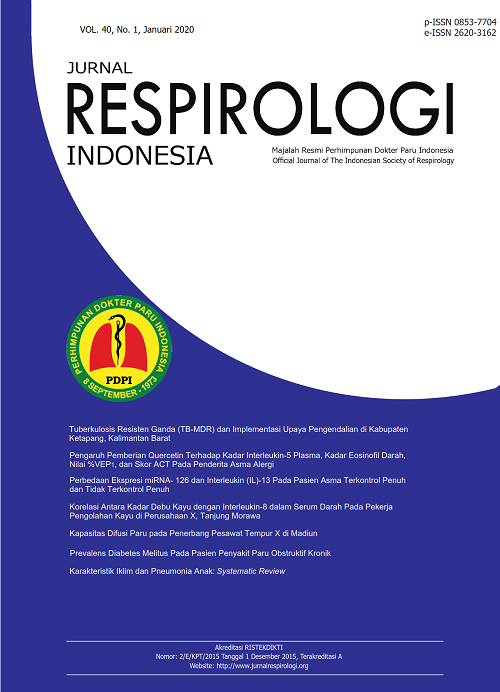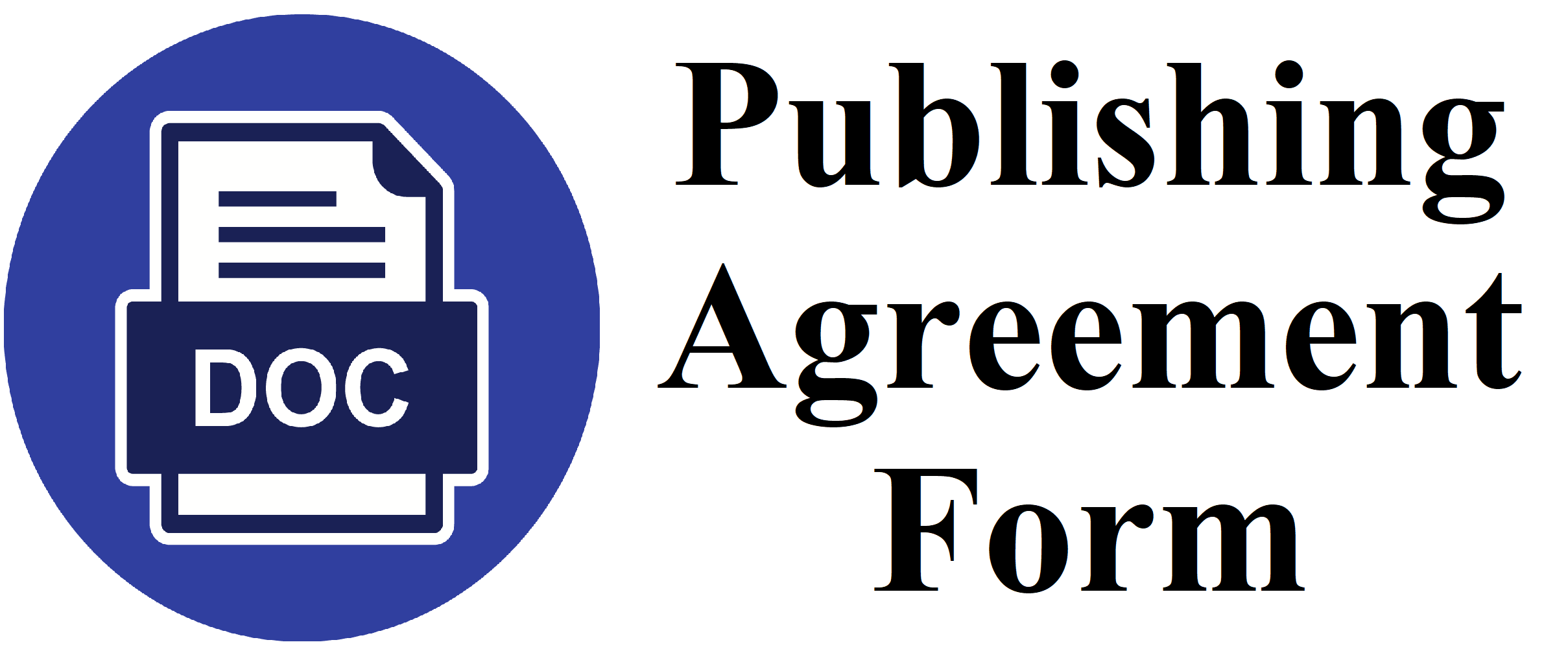Multidrug-Resistant Tuberculosis and Implementation of Control Measures in Ketapang District, West Borneo, Indonesia
DOI:
https://doi.org/10.36497/jri.v40i1.91Keywords:
MDR-TB, Multidrug-resistant Tuberculosis, KetapangAbstract
Background: Multidrug-resistant Tuberculosis (MDR-TB) has emerged as a threat of public health in Indonesia. The utilization of GeneXpert MTB/RIF as a rapid yet effective diagnostic tool enables early and appropriate treatment initiation of MDR-TB. This study aims in describing the occurrence of MDR-TB and the implementation of control measures in Ketapang District, West Borneo, Indonesia, since the utilization of GeneXpert MTB/RIF as a diagnostic tool. Methods: This is a cross-sectional descriptive study. The data were taken from medical record of patients with MDR-TB in Dr.Agoesdjam District General Hospital. The diagnosis was obtained from PCR-based analysis GeneXpert MTB/RIF of sputum sample, which detected Mycobacterium tuberculosis resistant to Rifampicin. Results: Seventeen subjects were included in the study. Subjects were 8 (47%) male and 9 (53%) female aged 24-75 years. Most subjects are farmers (35.3%) or housewives (35.3%), and did not receive formal education (41.2%). The main symptom reported upon admission was cough (41.2%). Direct microscopic smear of sputum detected acid-fast bacilli of +2 (29.4%) and +1 (29.4%) the most. The most common feature seen in thoracic X-ray was infiltrate in 100% of cases. Four subjects (23.5%) have type II diabetes mellitus, while one subject (5.9%) is infected with HIV. Subjects are categorized into new case (17.6%), failure of category 1 treatment (41.2%), and failure of category 2 treatment (41.2%). Treatment for MDR-TB has been initiated since 2014, while two subjects have not started taking the regimen. Among 15 subjects receiving treatment, one (6.7%) was recovered, 6 (40%) subjects deceased, and 8 (53.3%) subjects are currently still taking the regimen, while conversion occurred in 8 (53.3%) subjects. Conclusion: Using the GeneXpert MTB/RIF analysis, 17 cases of MDR-TB have been detected in Ketapang district. Management of MDR-TB has been conducted since 2014.Downloads
References
Kementerian Kesehatan RI, Direktorat Jenderal Pengendalian Penyakit dan Penyehatan Lingkungan. Pedoman Nasional Pengendalian Tuberkulosis. Jakarta: Kementerian Kesehatan RI; 2014.
Lisdawati V, Puspandari N, Rif’ati L, Soekarno T, Melatiwati M, Syamsidar K, et al. Molecular epidemiology study of Mycobacterium tuberculosis and its susceptibility to anti-tuberculosis drugs in Indonesia. BMC Infect Dis. 2015;15(366).
WHO. Global Tuberculosis Report 2014. Geneva: World Health Organization; 2014.
Centers for Disease Control and Prevention. Availability of An Assay for Detecting Mycobacterium tuberculosis, Including Rifampin-Resistant Strains, and Considerations of Its Use. MMWR. 2013;62(41):821-4.
WHO. Automated Real-Time Nucleic Acid Amplification Technology for Rapid and Simultenous Detection of Tuberculosis and Rifampicin Resistance: Xpert MTB/RIF System. Policy Statement. Geneva: World Health Organization; 2011.
van Kampen S, Susanto NH, Simon S, Astiti SD, Chandra R, Burhan E, et al. Effects of introducing Xpert MTB/RIF on diagnosis and treatment of drug-resistant tuberculosis patients in Indonesia: A pre-post intervention study. PLos One. 2015;10(6).
Kementerian Kesehatan RI, Badan Peneltian dan Pengembangan Kesehatan. Riset Kesehatan Dasar 2013. Jakarta: Kementerian Kesehatan RI; 2013.
Pradipta I, Forsman LD, Bruchfeld J, Hak E, Alffenaar JW. Risk factors of multidrug-resistant tuberculosis: A global systematic review and meta-analysis. Journal of Infection. 2018.
Wu B, Zhang L, Liu Z, He H, Pan A, Wang F, et al. Drug-resistant tuberculosis in Zhejiang Province, China: an updated analysis of time trends, 1999–2013. Glob Health Action. 2017;10(1).
Chan C, Bognar FA, Wong KH, Leung CC, Tam CM, Chan KCW, et al. The epidemiology and clinical manifestations of Human Immunodeficiency virus-associated tuberculosis in Hong Kong. Hong Kong Med J. 2010;16(3):192-8.
Verdecchia M, Keus K, Blankley S, Vambe D, Ssonko C, Piening T, et al. Model of care and risk factors for poor outcomes in patients on multi-drug resistant tuberculosis treatment at two facilities in eSwatini (formerly Swaziland), 2011–2013. PLoS One. 2018;13(10).
Zhang L, Pang Y, Yu X, Wang Y, Lu J, Gao M, et al. Risk factors for pulmonary cavitation in tuberculosis patients from China. Emerg Microbes Infect. 2016;5(10):e110.
Chuang P, Wu MH, Fan SY, Lin KY, Jou R. Population-based drug resistance surveillance of multidrug-resistant tuberculosis in Taiwan, 2007-2014. PLos One. 2016;11(11).
He X, Tao NN, Liu Y, Zhang XX, Li HC. Epidemiological trends and outcomes of extensively drug-resistant tuberculosis in Shandong, China. BMC Infect Dis. 2017;17:555.
Jaeger S, Juarez-Espinosa OH, Candemir S, Poostchi M, Yang F, Kim L, et al. Detecting drug-resistant tuberculosis in chest radiographs. International Journal of Computer Assisted Radiology and Surgery. 2018;13:1915-25.
Ronacher K, Joosten SA, van Crevel R, Dockrell HM, Walzl G, Ottenhoff THM. Acquired immunodeficiencies and tuberculosis: Focus on HIV/AIDS and diabetes mellitus. Immunol Rev. 2015;264:121-37.
Dooley K, Chaisson RE. Tuberculosis and diabetes mellitus: Convergence of two epidemics. Lancet Infect Dis. 2009;9(12):737-46.
Kidenya B, Webster LE, Behan S, Kabangila R, Peck RN, Mshana SE, et al. Epidemiology and genetic diversity of multidrug-resistant tuberculosis in East Africa. Tuberculosis (Edinb). 2014;94(1).
Monge S, Diez M, Pulido F, Iribarren JA, Campins AA, Arazo P, et al. Tuberculosis in a cohort of HIV-positive patients: epidemiology, clinical practice and treatment outcomes. Int J Tuberc Lung Dis. 2014;18(6):700-8.
Kapur A, Harries AD. The double burden of diabetes and tuberculosis - Public health implication. Diabetes Res Clin Pract. 2013;101:10-9.
Bailey S, Grant P. ‘The Tubercular Diabetic’: The impact of diabetes mellitus on tuberculosis and its threat to global tuberculosis control. Clinical Medicine. 2011;11(4):344-7.
Development NIoHRa. National Report: Basic Health Research. Jakarta: Development NIoHRa; 2011.
Dheda KGT, Gandhi NR, Murray M, Theron G, Udwadia Z, et al. Global control of tuberculosis: from extensively drug-resistant to untreatable tuberculosis. Lancet Respir Med. 2014;2(4):321-38.
Rumende CM. Risk factors for multidrug-resistant tuberculosis. Acta Med Indones. 2018;50(1):1-2.
Ragonnet R, Trauer JM, Denholm JT, Marais BJ, McBryde ES. High rates of multidrug-resistant and rifampicin-resistant tuberculosis among re-treatment cases: Where do they come from? BMC Infect Dis. 2017;17(1):36.
Alisjahbana B, Sahiratmadja E, Nelwan EJ, et al. The effect of type 2 diabetes mellitus on the presentation and treatment response of pulmonary tuberculosis. Clin Infect Dis. 2007;45:428-35.
Lv L, Li T, Xu K, Shi P, He B, Kong W, et al. Sputum bacteriology conversion and treatment outcome of patients with multidrug-resistant tuberculosis. Infect Drug Resist. 2018;11:147-54.
Alene K, Yi HZ, Viney K, McBryde ES, Yang KY, Bai LQ, et al. Treatment outcomes of patients with multidrug-resistant and extensively drug resistant tuberculosis in Hunan Province, China. BMC Infect Dis. 2017;17:573.
van Altena R, de Vries G, Haar CH, de Lange WCM, Magis-Escurra C, van den Hof S, et al. Highly successful treatment outcome of multidrug-resistanttuberculosis in the Netherlands, 2000–2009. Int J Tuberc Lung Dis. 2015;19(4):406-12.
Downloads
Additional Files
Published
Issue
Section
License
- The authors own the copyright of published articles. Nevertheless, Jurnal Respirologi Indonesia has the first-to-publish license for the publication material.
- Jurnal Respirologi Indonesia has the right to archive, change the format and republish published articles by presenting the authors’ names.
- Articles are published electronically for open access and online for educational, research, and archiving purposes. Jurnal Respirologi Indonesia is not responsible for any copyright issues that might emerge from using any article except for the previous three purposes.
















